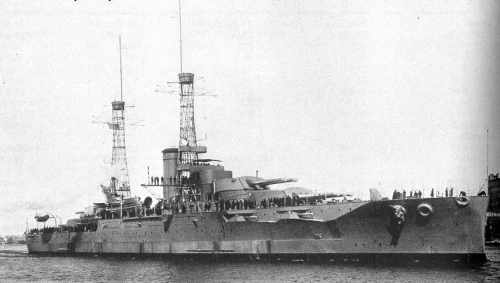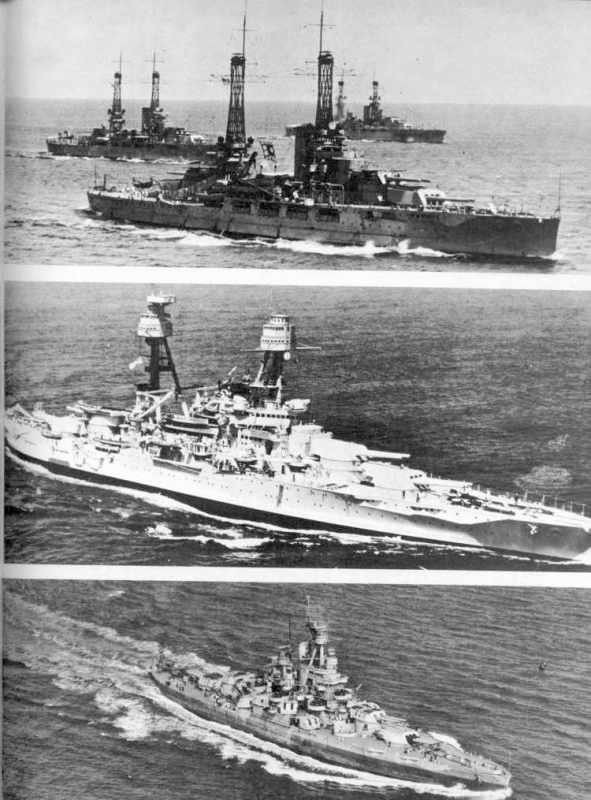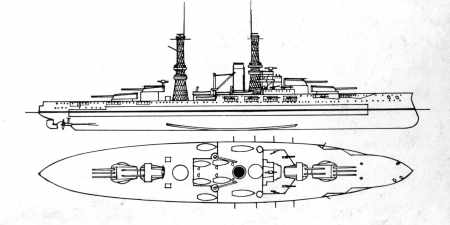

USS Nevada
In the last months of 1912 a new class of battleship was laid down
in the United States at Quincy, Massachusetts, and Camden, New Jersey,
which was to have a most profound and lasting influence on capital-ship
design all over the world. The ships were the Oklahoma and Nevada, America's
first "Second Generation" Dreadnoughts. They can be considered as the genesis
of a family of ten more American battleships, and the family tree of every
"Third Generation" capital ship can be traced back to them.
SPECIFICATIONS
Displacement: 27,500 tons (normal), 28,900 (load)
Dimensions: 575ft (water line) length x 95ft 3in beam
Guns: 10x14in 45cal. (2x3, 2x2);
21x5in 51cal (21x1);
reduced to 12x5in in 1917
2x3in AA (2x1) added
in 1917
Torpedo Tubes: 4x21in (submerged, beam)
Armor: Main belt 13 1/2 - 8in
NEVADA CLASS
| Ship | Laid Down | Launched | Completed | Built By |
| BB-36 Nevada | 04 November 1912 | 11 July 1914 | March 1916 | Fore River |
| BB-37 Oklahoma | 26 October 1912 | 23 March 1914 | May 1916 | New York Ship |
General: The two Nevada class were the first 'superdreadnoughts' laid down for the U.S. Navy and they marked a radical departure from established practice. For the first time belt armor was concentrated in a citadel to protect the most vital parts of the ship--magazines and machinery; other parts of the ship were protected by internal bulkheads and decks. The chief advantage was the saving in weight which could be devoted to the heaviest belt armor possible, as opposed to thinner armor spread over a wide area of hull. This 'all-or-nothing' system of armoring was universally adopted in other navies after World War I.
The Nevadas were also the first American battleships to adopt oil fuel, and triple turrets. They were the first single funnelled battleships since the old Texas (1892).
Gunnery: The 14in guns were mounted in new pattern turrets, which were unique in that all the guns were mounted in a single sleeve, and had to be elevated and depressed together. This made salvo-firing awkward, but as the U.S. Navy was still using the 'follow-the-pointer' system and had not yet adopted the director system, the disadvantage was not immediately obvious. As in the previous class, many of the 5in guns were badly positioned and nine were suppressed in 1917.
Protection: At normal load draft the armor extended from 9ft 6in above the waterline to 8ft 6in below, and was arranged in a single strake, with plates laid vertically. The ends of the ship were left totally unprotected on the waterline, and the 5in guns were similarly unarmored. The funnel uptakes were given a conical mantle of 12in armor.
Appearance: They were distinguished from earlier dreadnoughts by the single funnel and widely spaced 'basket' masts. From 1917 the forward and after embrasures for 5in guns, in the hull were plated over. In 1918 Oklahoma was dazzle-painted and both ships had the normal range clocks and deflection scales added.
Careers
Nevada: Based in Guantanamo Bay, Cuba when war broke out; returned
to Norfolk, Virginia to train destroyer crews and gun crews for armed merchantmen;
as temporary flagship of Rear-Admiral Rodgers left Hampton Roads 13 August
1918 in company with Oklahoma for Bantry Bay, Ireland; arrived 23
August and proceeded to Scapa Flow to join 6th Battle Squadron, Grand Fleet;
with other ships escorted President Wilson to Brest in December 1918 before
returning to New York; heavily damaged by Japanese aerial torpedos at Pearl
Harbor 7 December 1941, but repaired and served with distinction during
the remainder of World War II; used as target ship at Bikini and sunk 31
July 1948.
Oklahoma: Served with Battleship Division 6, U.S. Atlantic Fleet in April 1917; stationed at Norfolk and New York until August 1918, when she and Nevada were sent to Berehaven, Bantry Bay to join the British Grand Fleet; escorted President Wilson to Brest and then returned to New York; after peacetime service on various stations she was part of the U.S. Pacific Fleet, at Pearl Harbor on 7 December 1941; during the Japanese attack the OKLAHOMA was moored outboard of the MARYLAND, took at least three torpedoes in rapid sucession, and capsized to port. She was finally raised in 1944 and because of the progress of the war and the availability of new construction, it was deemed she was not worth the effort at repair. The OKLAHOMA was slated to be scrapped. On her voyage to the west coast, she parted her tow line and sank.
USS Nevada BB-36 Transformations

USS Nevada BB-36
Upper photo Along with her sister ship USS Oklahoma, the most
formidable battleships in the world when completed in May, 1916, the month
Jutland was fought. Besides being the first single-funnel American Dreadnoughts,
they instituted the principle of "all-or-nothing" armored protection, which
was later followed by every navy until the demise of the Dreadnought.
Middle photo Nevada is next seen in 1935, after her refit and
reconstruction eight years earlier in 1927, when vast tripods replaced
lattice masts, funnel was moved aft, and secondary battery raised from
its vulnerable position on the main deck to the forecastle deck.
Lower photo Finally, the same ship is seen transformed yet again
for service in the new air age, with her old secondary armament replaced
by eight dual 5-inch 38 mounts augmented by a multitude of 40mm and 20mm
light antiaircraft guns. Oklahoma total loss at Pearl Harbor; Nevada survived
her serious injuries received at Pearl Harbor.

SOURCES:
Fear God and Dread Nought
Click on any [Item] below to go to that page
[Return to Home Page]
[USS Monitor]
[USS Monterey BM-06]
[USS Indiana BB-01]
[USS Virginia BB-13]
[First Generation Battleships]
[USS South Carolina BB-26]
[Second Generation Battleships]
[USS Nevada BB-36]
[USS South Dakota BB-49]
[Third Generation Battleships]
[USS Iowa BB-61]
[USS Lexington CC-01]
[USS Alaska CB-01]
[Battleship List]
[Sources]
[Glossary
[Favorite Links]

